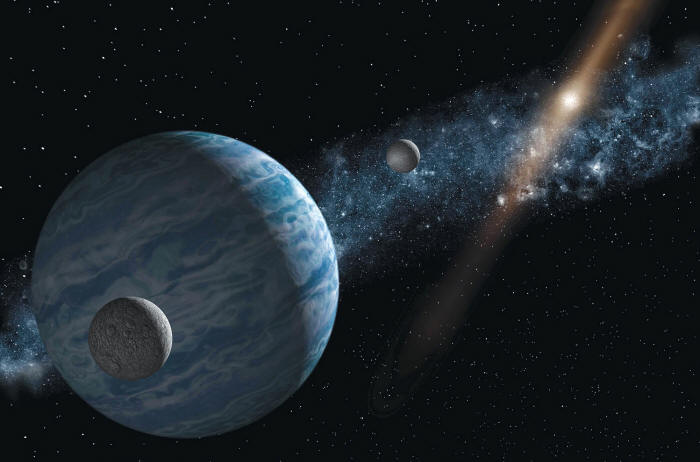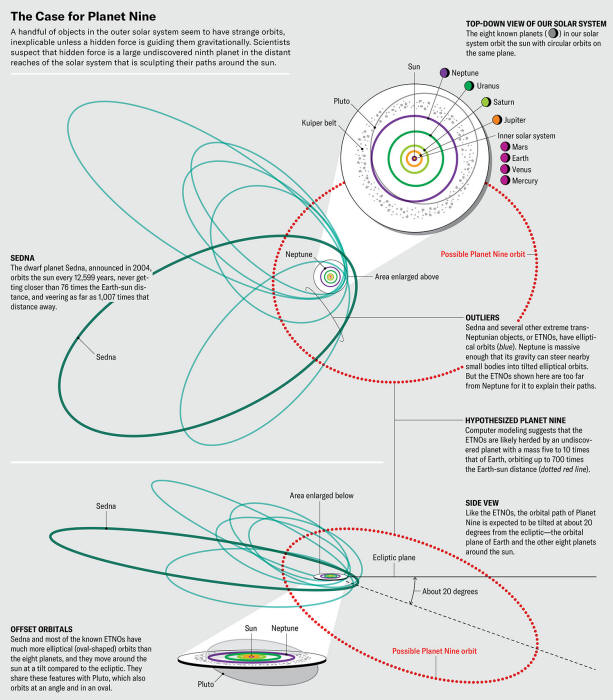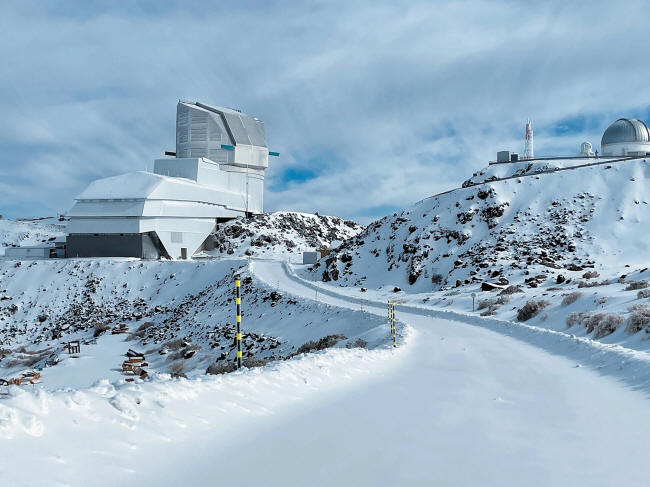|
hidden world in the solar system, a new telescope should find it...
Thanks to his research, Pluto, the solar system's ninth planet, was removed from the pantheon - and the public cried foul.
About 10 years ago Brown's daughter - then around 10 years old - suggested one way he could seek redemption: go find another planet.
Yet Brown may now be on the brink of fulfilling his daughter's wish.
Evidence he and others have gathered over the past decade suggests something strange is happening in the outer solar system:
According to Brown, that force is coming from a
ninth planet - one bigger than Earth but smaller than Neptune.
A new telescope, the Vera C. Rubin Observatory in Chile, is about to open its mechanical eyes.
When it does, it should catch millions of
previously undetected celestial phenomena, from distant supernovae
to near-Earth asteroids - and, crucially, tens of thousands of new
objects around and beyond Pluto.
...says Megan Schwamb, a planetary
astronomer at Queen's University Belfast in Northern Ireland - and,
just maybe, the solar system will once again have a ninth planet.
But at roughly 1,500 miles in diameter, it was just a little larger than Pluto.
Either Eris was going to become a new planet, or
Pluto wasn't what we thought.
would be huge. Such a discovery could change what we know
about our solar system's past...
There are countless worlds just like them,
known as trans-Neptunian objects, but they are very hard to see.
They announced one of these, named Sedna, in 2004.
The closest it gets to the sun is 76 astronomical units, or AU (1 AU is equivalent to the average Earth-sun distance), which is so mindbogglingly far-flung that a person standing on it could obscure the furious light of the sun with the head of a pin.
Back then, it was the most distant object ever detected in the solar system.
In fact, it resides beyond the Kuiper belt and was viewable only as a fuzzy little dot shifting between the stars.
Though poorly defined, ETNOs are key players in the saga of Planet Nine, which is also referred to as Planet X.
In 2014 Trujillo (then at the Gemini Observatory in Hawaii) and astronomer Scott S. Sheppard of Carnegie Science in Washington, D.C., published a paper on Sedna and another remote object called 2012 VP113, whose closest approach to the sun was a staggering 80 AU.
Both dance back and forth across the heliopause, the putative boundary of our solar system that separates the magnetized wind of the sun from the gas and dust found between stars, beyond which interstellar space begins.
They seemed inexplicable.
Sedna and 2012 VP113 (along with a few other, similarly odd objects) are on orbits so stretched out and distant that the gravitational influence of something had to have positioned them there and paved their strange orbital highway around the sun.
But what was that something...?
At these distances the immense gravitational fields of the giant planets, including Neptune, don't have any significant effect on them; the only thing that should be influencing their orbits is the sun.
He and others figured an invisible gravitational actor had to be invoked to explain these aberrant wayfarers.
In 2014 Sheppard and Trujillo suggested that Sedna, 2012 VP113 and company may have those outlying orbits thanks to a hidden planet - one anywhere from two to five Earth masses in size - that is pulling at them and gradually changing the shapes and positions of their original orbits over time.
The best way to find out if that's true is to use these ETNOs and their orbits,
The idea appealed to Brown, who took Sheppard and Trujillo's 2014 study down the halls of Caltech to astronomer Konstantin Batygin.
Whereas Brown is more of an observer of the night sky, Batygin is a theorist, someone who wants to know why the cartography of the solar system is the way it is.
Brown and Batygin ruminated on six ETNOs and noticed something weird was going on.
Unlike the eight known planets, whose orbits are approximately circular and are oriented along the same flat plane, known as the ecliptic, these six objects - including Sedna - had elliptical orbits and were tilted about 20 degrees with respect to the ecliptic.
The six also made their closest approaches to the sun in the same region of space. They were all too far out to be within Neptune's gravitational reach, but something appeared to have crafted their orbits.
Brown and Batygin's computer models suggested the only reasonable possibility was,
This world, perhaps one exiled from the warmer confines of the solar system during its chaotic earlier years, managed to cling to the sun's gravitational ropes.
And as it whirled through the distant darkness, it wielded its own gravitational influence on those passing six orbs, herding them into similar, strange new orbits.
Since Sedna's discovery in 2004, the notion of a huge, incognito planet had come up on several occasions. But Brown and Batygin's 2016 paper announcing their calculations was a clarion call:
The hunt for a missing planet is inherently peculiar.
Finding a ninth planet would be huge.
Beyond consoling those in the public who still mourn Pluto's demotion, such a discovery could change what we know about our solar system's past.
Any objects in, and beyond, the Kuiper belt are,
Did planets manage to form that far from the sun, or did they migrate out there?
Most orreries of planets moving around other stars include a mini Neptune of some variety.
If it exists, Planet Nine is big compared with Earth - Brown's best guess is that it hovers around seven Earth masses.
But it's so far away that it's beyond the detection capabilities of most telescopes. In general, observatories have a choice:
Space is rather expansive, so trying to zoom in on one minuscule patch of it in the hope of finding a single object is extremely unlikely to succeed.
Jen Christiansen. Source: Caltech/R. Hurt (IPAC) (ETNO and Planet Nine orbital reference)
Many astronomers - not just Brown, Batygin, Sheppard and Trujillo - have tried looking.
Several more ETNOs have been found, including the Goblin (discovered around Halloween 2015), Farout and FarFarOut - more gravitational probes for Planet Nine hunters to study.
But to date, Planet Nine itself has eluded them.
There is, of course, a chance that they can't find it not because Planet Nine is stealthy but because it doesn't exist. Over the past decade various alternative hypotheses have sprung up to try to explain Sedna and its cohort's weirdly clustered orbits.
One possibility is that there is a Planet Nine but not the canonical one:
In 2017 Kathryn Volk, an orbital dynamics researcher at the University of Arizona, thought the orbits of various trans-Neptunian objects hinted at the presence of a Mars-esque world within the Kuiper belt.
Additional observational data on other distant objects has since undercut her team's hypothesis, and although the possibility of a Mars-like Planet Nine has come up at astronomy conferences, Volk is now skeptical.
In 2020 scientists suggested that an icy ring of primordial debris, if massive enough, could also be sculpting the orbits of several ETNOs.
Brown notes that we see inclined frosty rings around other stars, but those rings are thought to be held in place by the gravitational influence of another hefty planet, making this a more complicated explanation than Planet Nine alone.
It's also been suggested that perhaps a passing star or a rogue planet zipping through space could have dragged Sedna and its friends onto their weird orbits long ago. In 2019 researchers even wondered whether a tiny black hole might be the culprit.
When I raise this possibility to Brown, he grins.
He disappears for a moment, then reemerges holding a sphere about the size of a volleyball.
Brown chuckles.
He puts down his tiny black hole.
After all, he says, we see planets like that on distant orbits around other stars all the time.
Trujillo is a little more circumspect when considering alternative explanations. Sure, he says, they could be right; those theories deserve to be explored.
But the fact remains that,
Though not as adamant as Brown, Batygin is certainly bullish. In astrophysics,
Arguably, the greatest challenge to the Planet Nine story is the suggestion that Sedna and company may not have strange orbits at all.
Astronomers cannot see every region of space clearly. If an observatory is afflicted by bad winter weather, then data will be lacking for that corner of the night sky.
ETNOs also spend most of their unfathomably long orbits so far from Earth that they glint in sunlight only when they reach their closest approach to the sun.
Then there's the Milky Way.
It's beautiful but bothersome to astronomers.
Because astronomers know about only a small number of Kuiper belt objects and ETNOs, some scientists skeptical of the Planet Nine hypothesis think we simply do not have enough information to know whether worlds like Sedna really are on strange orbits or just look like they are for the moment.
"Each year we don't find [Planet Nine], the probability of it actually existing goes down dramatically." Mario Juric University of Washington
Think of it this way:
The problem is that, for now, your flashlight isn't bright or wide enough to let you see the rest of them.
This misperception is caused by what's known as an observational bias. To see whether the case for Planet Nine was afflicted by one, Lawler and her colleagues turned to the Outer Solar System Origins Survey (OSSOS).
Between 2013 and 2017, OSSOS used the Canada-France-Hawaii Telescope to scan eight patches of the night sky and ultimately identified more than 800 new Kuiper belt objects.
Eight objects had average distances from the sun greater than 150 AU, making them ETNOs - the kinds of objects that could be used as gravitational probes for Planet Nine.
And their orbits were not clustered at all...
If a giant hidden planet is influencing these eight objects, they should exhibit the same type of clustering as those being used to invoke Planet Nine. But they don't...
The OSSOS data cannot rule out Planet Nine, but they do suggest that what may look like clustered orbits sculpted by an invisible world could, in fact, be an illusion.
Authors of another bias-checking study, using the Dark Energy Survey, came to the same broad conclusion in 2020.
The soon-to-open Vera C. Rubin Observatory
stands
atop the Cerro Pachón mountain range in Chile.
The crux of the debate is that we are dealing with small-number statistics:
Thankfully, that search is about to get a lot easier.
In May 2024 a nearly 7,000-pound, car-size camera was moved from its construction site in California to a mountaintop in Chile.
After a 10-hour flight and a several-day, winding, bumpy drive to an 8,700-foot-high peak in the Cerro Pachón mountain range, the 3,200-megapixel camera - the world's largest - arrived without a single scratch.
Like the prize jewel for a monarch's crown, the $168-million camera was then almost ready to be set in place within the nearly finished Vera C. Rubin Observatory.
The observatory will see its first light sometime in early 2025.
Thanks to its enormous field of view, Rubin will take images of the entire night sky viewable from the Southern Hemisphere night after night - and its house-size nest of mirrors will gather up remarkably distant starlight, meaning nearly everything that shimmers or shifts about will be photographed.
Rubin - a venture funded by the U.S. National Science Foundation and the Department of Energy - is named after the late, great astronomer who, by looking at the way stars and galaxies stuck together more than could be explained by the gravity of visible matter alone, uncovered compelling evidence for dark matter.
Her namesake is aptly set to find a cornucopia of concealed objects, from faraway collapsing stars to millions of asteroids and even a bunch of interstellar objects in our own solar system.
The Kuiper belt, whose population and structure are only vaguely known, stands to be greatly illuminated by Rubin. After nearly four decades of searching, astronomers have found about 4,000 objects out there.
I bring that up with Brown, who laughs.
But ultimately, he has his eyes on Planet Nine. And, he says, Rubin is probably going to find it... Here's how:
For solar system science, astronomers will see a list of moving objects - those known and those previously unidentified - with orbital parameters based on the current crop of Rubin observations.
Researchers seeking Planet Nine can then use the newly discovered trans-Neptunian objects to see whether the case for the planet is stacking up or collapsing.
When lots of ETNOs have been found, Brown says, it will become clear whether the clustered orbits one would expect to be caused by a hidden planet - like those of Sedna and company - are present.
And because Rubin will see the entire southern sky, any observational bias will be quickly ruled out.
It's also possible that among the moving objects Rubin detects will be Planet Nine itself.
If it's more like Uranus or Neptune - a hydrogen-enveloped orb with plenty of ice - it will reflect a lot of light, making it easier to spot. (Even in that best-case scenario it would probably look like a pinprick of light in a Rubin image.)
Pessimistically, Batygin says,
If it's hanging out in front of the Milky Way, that would be,
Jurić notes that Rubin's software will do its best to subtract that bright conflagration of starlight, revealing, he hopes, anything concealed within it.
Will that work...?
Jurić thinks so,
Worst-case scenarios aside, astronomers expect that the mission to find Planet Nine will be over in a few years.
In just one, Earth (and Rubin) will have circled the sun once. Only inclement weather will prevent us from seeing what's out there; a bad winter month may take one month of full-sky coverage away, but the telescope should be able to capture it the next year.
And after a couple of years, the existence (or nonexistence) of Planet Nine will be, to most astronomers, unequivocal.
Rubin is,
Most astronomers are happy to wait and find out what Rubin reveals.
Schwamb, whose Ph.D. adviser was none other than Mike Brown, treads carefully.
But Brown and Batygin have never been surer.
In a 2024 study, they analyzed the orbits of 17 trans-Neptunian objects, each with a bizarre feature:
Objects that cross Neptune's orbit like that should get ejected from the solar system, so,
Something is grabbing orbs that linger at the very edge of the solar system and putting them on orbits that take them far closer to the sun than they would otherwise get, the scientists surmise.
Their study used virtual re-creations of the solar system and tried to see what kinds of objects had the gravitational influence to sculpt these orbits - including passing stars, the Milky Way itself and Planet Nine.
According to the researchers, the versions of reality without Planet Nine make no sense.
This outcome is,
If the planet does exist, there's a good chance that Brown and Batygin might not find it first.
Batygin, ever the theorist, says the discovery is what matters most, regardless of who claims it.
If Planet Nine is real,
He admits that should he not be the one to first cast eyes on it, he would feel an initial gut punch of frustration.
But he'd be satisfied if he and his colleagues were proved right all along, and he met his daughter's challenge of redemption - and he would be thrilled that the history of the solar system would change, once again, partly because of his research.
Every telescope, on Earth and in space, might be zeroing in on its secrets.
Whatever it's like, Brown says,
|




